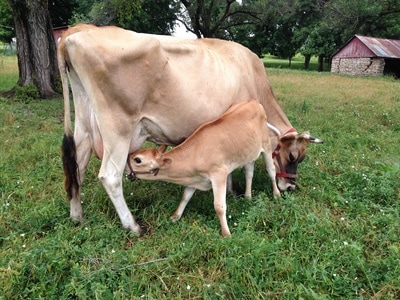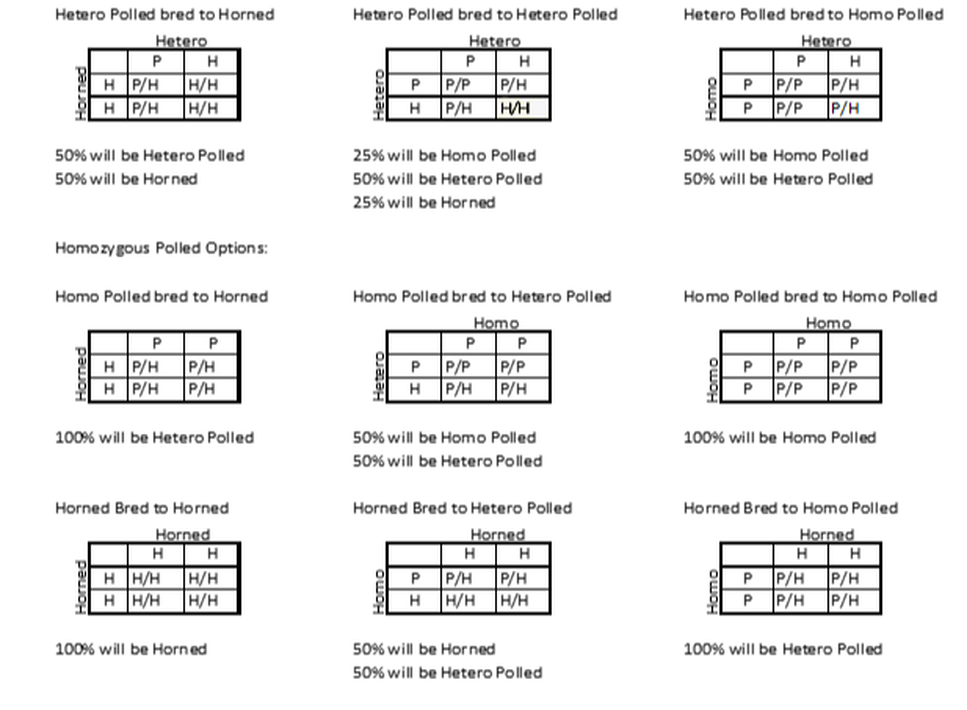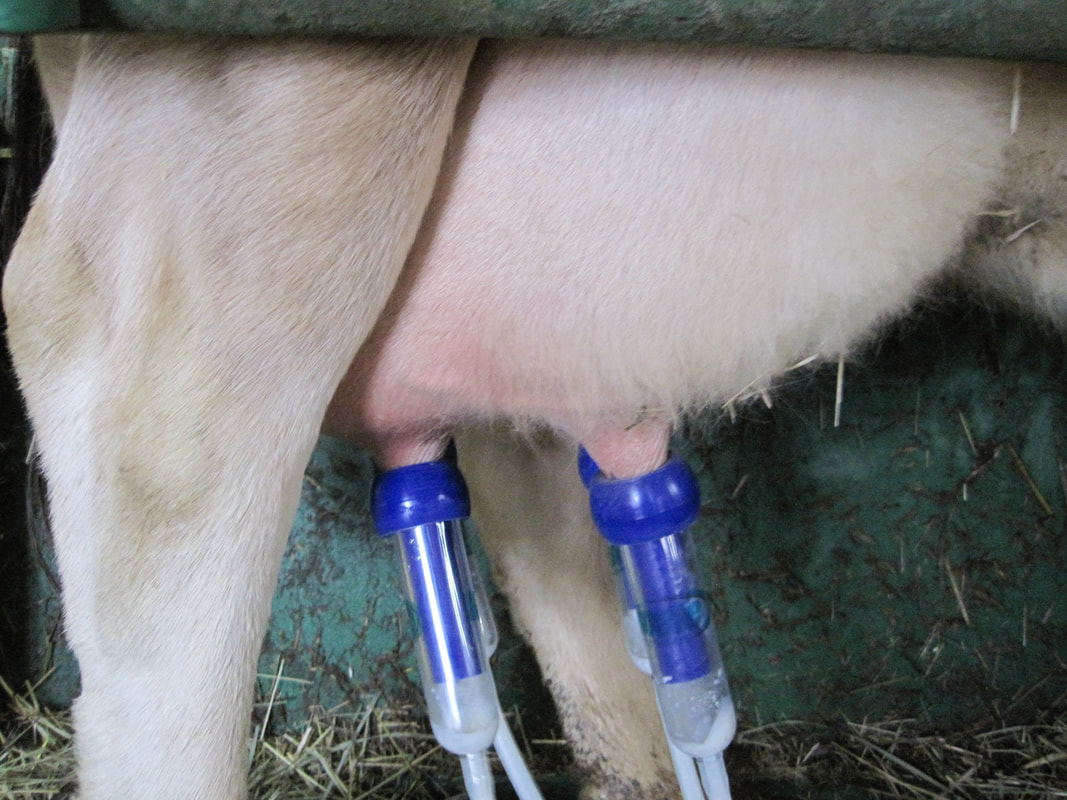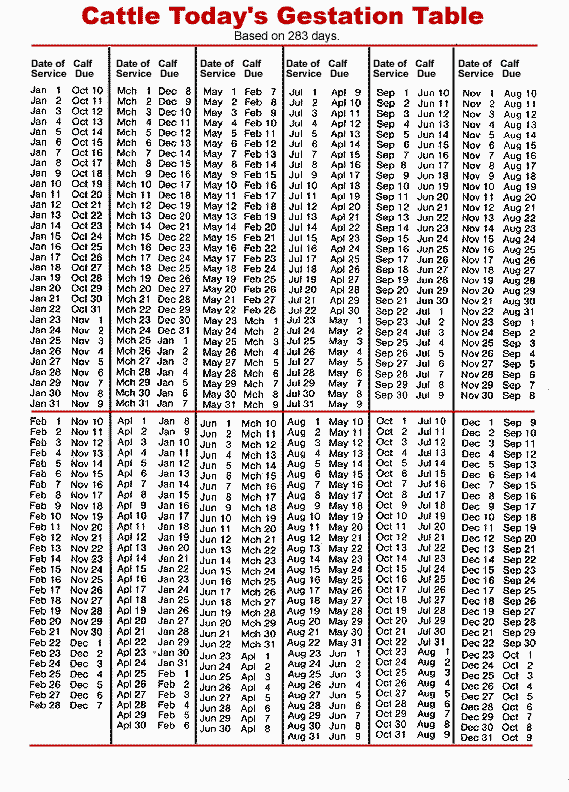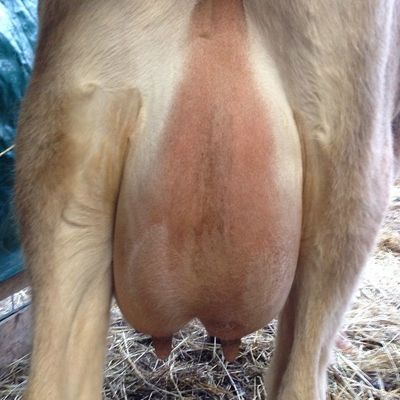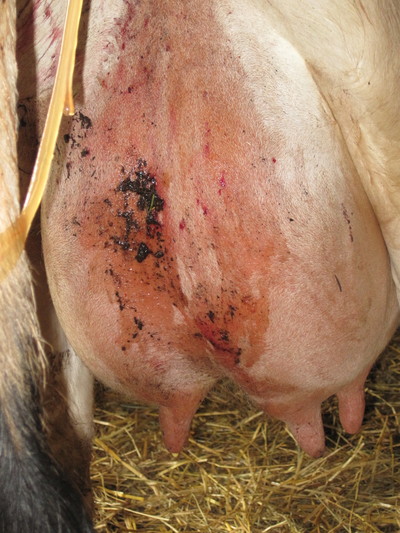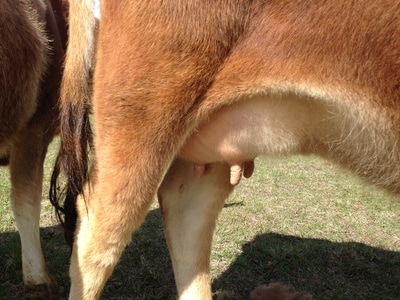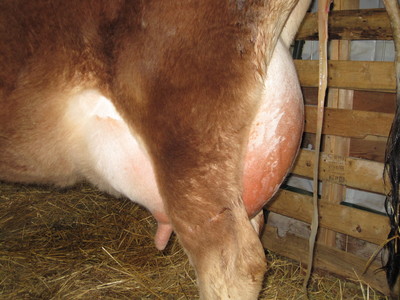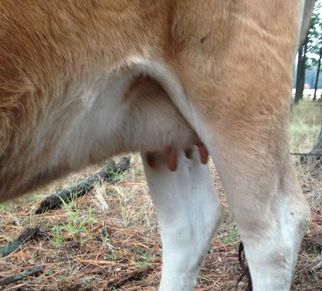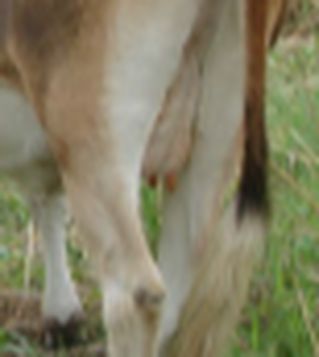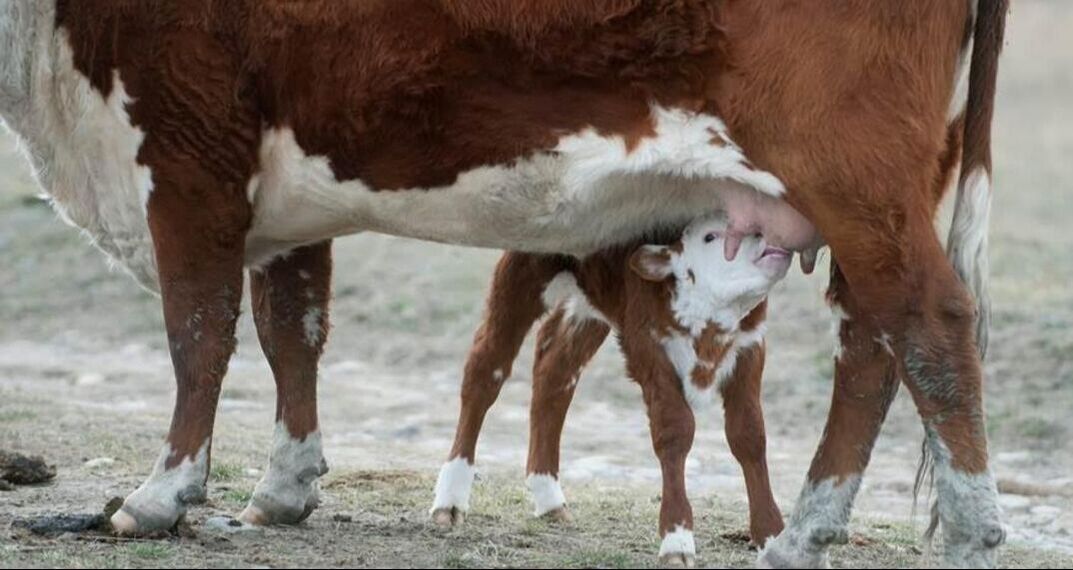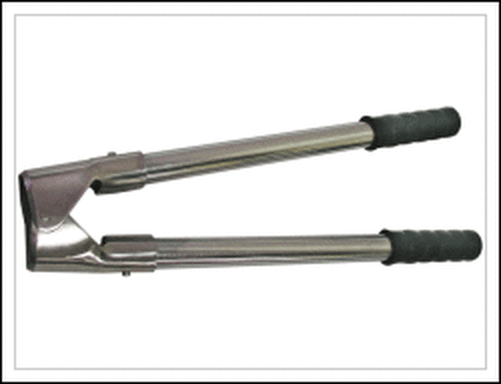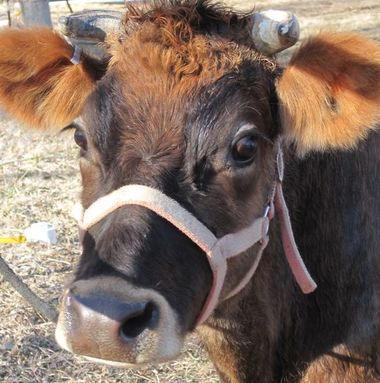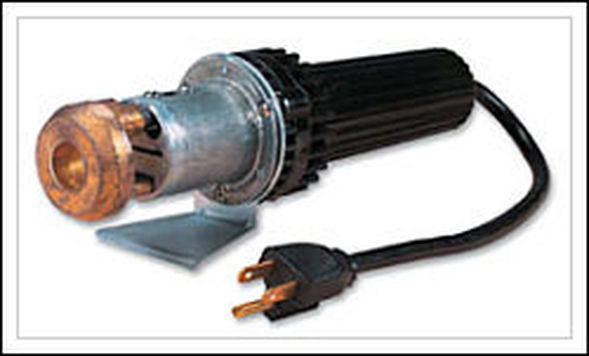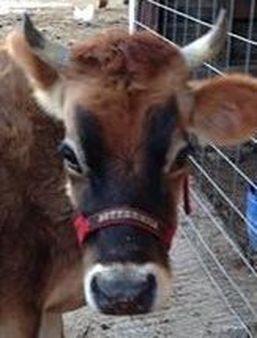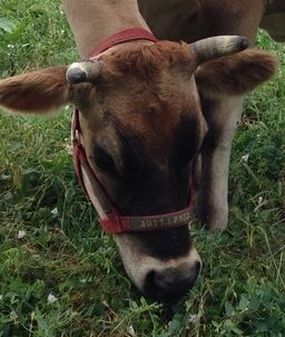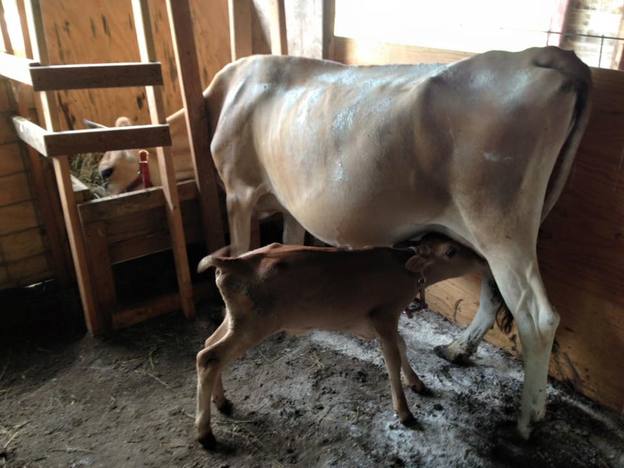Frequently Asked Questions:
PUREBRED Mini Jersey Cattle
Some of this information is our own opinions, formed From our experiences.
It is only provided for your self education, to take away what you wish.
THERE ARE MANY EMBEDDED LINKS TO FURTHER RESEARCH THE TOPICS.
Thank you FOR VISITING US AND WE HOPE YOU FIND THIS HELPFUL.
See available Dairy cows here
LAST UPDATED 7/6/2024
What is a PUREBRED Mini Jersey?
Mini refers to the stature at maturity. Purebred Miniature Jerseys are 42" and under when measured at the top of the hip at 3 years old. Purebred Miniature Jerseys are bred to be proportionally smaller than full-size Jerseys. The purebred part refers to the fact they pass the same DNA Breed Based Representation (BBR) purity test. We breed miniaturized Jerseys. They should not appear to have tiny legs or a large head on a normal sized torso. Often, these disproportionate animals are Dwarves, carriers of a genetic defect "Condro" gene. This came from crossing Jerseys with Dexter cattle to reduce the height of the offspring in one generation. These offspring won't breed true. Breeding two carriers of this mutation creates a terminal "Bulldog" calf that won't survive, usually dying before birth. Our herd has been tested and proven not to be carriers of the Dwarfism defect. Every bull that we use for breeding is tested to ensure we're breeding true Purebred Miniature Jerseys.
What does IT MEN TO BE dna verified 100% pureBRED MINI Jersey?
Breed Base Representation (BBR) is a genomic test that assesses the degree to which alleles in an individual animal’s genome are in common with the allele frequency of the breed reference groups for Ayrshire, Brown Swiss, Guernsey, Holstein and Jersey. American Jersey Cattle Association (AJCA) offers genomic testing. For about $48 you can confirm the amount of Jersey DNA (purity) and verify the parentage of your cow, if the parents are genotyped and in the database.

Generation Count (GC) demonstrates the depth of Jersey ancestry. An animal’s name will include a suffix enclosed in braces { } to indicate the number of generations of AJCA recorded ancestry from one through six. The offspring of a mating will be one generation count higher than the lowest parent. The GC is dropped when seven or more generations of ancestors are recorded by the AJCA. These are then recorded as Herd Registry (HR).
Unregistered Genetic Recovery animals are recorded with prefix UR unless qualified by genotyping to be recorded with GC {1}. The more an animal’s genetic makeup resembles its breed reference group, the higher its BBR for the primary breed. A BBR lower than 90 usually indicates evidence of crossbreeding. The Council on Dairy Cattle Breeding (CDCB) policy is to report BBR values of 94 or greater as 100 due to standard deviations. Rules and publication policies for BBR are established by the CDCB.
We want to assure you we don't crossbreed our Mini Jerseys. While building our perfect Mini Jersey herd not all the pure Jerseys we utilized were registered. This isn't uncommon in Mini Jersey breeding programs, many of which preexist Mini registries. After four generations of work we utilized BBR and registered all our cows with AJCA. Several are double registered with Purebred Mini Jersey Society, an open Herd Book. All of our cattle are tested for BBR. Don't take our word for it, DNA and genetics don't lie!
Unregistered Genetic Recovery animals are recorded with prefix UR unless qualified by genotyping to be recorded with GC {1}. The more an animal’s genetic makeup resembles its breed reference group, the higher its BBR for the primary breed. A BBR lower than 90 usually indicates evidence of crossbreeding. The Council on Dairy Cattle Breeding (CDCB) policy is to report BBR values of 94 or greater as 100 due to standard deviations. Rules and publication policies for BBR are established by the CDCB.
We want to assure you we don't crossbreed our Mini Jerseys. While building our perfect Mini Jersey herd not all the pure Jerseys we utilized were registered. This isn't uncommon in Mini Jersey breeding programs, many of which preexist Mini registries. After four generations of work we utilized BBR and registered all our cows with AJCA. Several are double registered with Purebred Mini Jersey Society, an open Herd Book. All of our cattle are tested for BBR. Don't take our word for it, DNA and genetics don't lie!
How do you identify a pure jersey?
- Coloration: Jersey cattle coat color ranges from a light fawn to almost black. Standard Jerseys can come in the very rare brindle pattern that traces back to the 1700s. When brindle coloring is found in Mini Jerseys it usually stems from crossbreeding with Dexter Cattle or Aberdeen to reduce the height from a taller Jersey. Some Jerseys may have white on them, from diamond-shaped patches on their foreheads, to white patches over their torso they will never be all black and white like a Holstein.. Black Jerseys almost always have a tan-colored saddle in the middle of their backs, from the withers to the tail. They should have lighter coloration around their noses and eyes, on the inside of each leg, and often around the top of each hoof. A lot of fawn-colored mature Jerseys have a darker mask from just above their eyebrows to just before their noses. There will be lighter hair coloration around their eyes and noses. Bulls have darker coloration over their necks to their shoulders, deepening with age. All Jerseys have dark brown-black eyes surrounded by dark pigmented skin, usually black tongues, and black noses. They typically have black hooves and a dark tail-switch. A Jersey with a pink nose or eye rims is not pure blooded, as this is not a Jersey trait.
- Body type and characteristics: Cows show very marked refinement about their heads and shoulders, carry long, straight top lines, and usually carry out long and level at the rump. For their size, they are usually deep in the body and full and deep in the barrel. There is no more appealing dairy animal than the well-balanced Jersey cow. Jersey cows have a large udder to accommodate the demand for producing more milk than their calf can consume. Jersey bulls, while small as compared to the other dairy breeds, are extremely masculine. They are quite muscular about their chest and shoulders and are considerably less refined throughout than are the females. The same general qualities of straight lines and dairy conformation as are found in the cows are desired in bulls. Standard size Jerseys tend to be smaller, averaging under 50", with a mature weight of around 1000 lbs for cows and 1500 lbs for bulls.
- Head characteristics: Jersey cows are soft, feminine looking animals, with a similar head-shape to Shorthorn cows. Ears come from high on the sides and the bridge of the nose is preferred to have a dish shape. Jerseys are often horned, though genetics for Polled Jerseys are becoming more common.
- Other characteristics: Female Jerseys are docile and affectionate, usually bonding with whoever feeds and milks them. Jersey bulls are infamous for their aggressiveness and unpredictability. It is folly to trust any dairy bull, particularly Jerseys, past a year of age. Never turn your back on a bull of any age. Always have an escape route pre-planned when entering his field.
What Registry do you use?

There are several registries available for Mini Jerseys. Our Mini and Midsize Jerseys have been genetically tested and DNA verified 100% Pure Jersey. They are dual registered with
Purebred Mini Jersey Society (PMJS) open Herd Book and American Jersey Cattle Association (AJCA). PMJS requires DNA, genomics, verified height, and negative dwarfism tests to be considered for the PMJS open Herd Book.
Our small Standard size Jerseys are utilized in our breeding program to add strong dairy traits and A2/A2 to our MIni Jersey bloodlines. They are registered with AJCA. This registration service is used by the top dairies in the country. With pedigrees going back to the first Jerseys brought over from the Isles, there's no doubt of the longevity of this registry.
Purebred Mini Jersey Society (PMJS) open Herd Book and American Jersey Cattle Association (AJCA). PMJS requires DNA, genomics, verified height, and negative dwarfism tests to be considered for the PMJS open Herd Book.
Our small Standard size Jerseys are utilized in our breeding program to add strong dairy traits and A2/A2 to our MIni Jersey bloodlines. They are registered with AJCA. This registration service is used by the top dairies in the country. With pedigrees going back to the first Jerseys brought over from the Isles, there's no doubt of the longevity of this registry.
How do we buy one of your mini jersey cows?
We don't do a first come, first served system. This doesn't serve the best interest of the cow. We're a small boutique operation, only offering a couple cows for placement each year. This allows us to be reasonably picky. We require a vet reference, photos of the living conditions you can offer a cow, and enough time to have a few conversations about your expectations and the cows we have available. In return, we will give serious buyers our vet and AI Tech's contact information so you can check our references as well. There are lots of pictures on our website and Facebook pages for you to see how our cows are loved and how they live.
We research the market constantly and poll other breeders before we set a fair price. That price is not negotiable. We feel if someone can't afford a fair market price, then vet care and feed will be a hardship. Cows aren't cheap to keep!
We consider the size of your family, the production of the cow, the age of your children, temperament of the cow, prior milking experience of you and the cow both, and anything else relevant. You're picking a cow best friend and we want you all to be happy together for a very long time.
More to come on this subject for sure!
We research the market constantly and poll other breeders before we set a fair price. That price is not negotiable. We feel if someone can't afford a fair market price, then vet care and feed will be a hardship. Cows aren't cheap to keep!
We consider the size of your family, the production of the cow, the age of your children, temperament of the cow, prior milking experience of you and the cow both, and anything else relevant. You're picking a cow best friend and we want you all to be happy together for a very long time.
More to come on this subject for sure!
What does A2/A2 mean?
A2 refers to the Beta-Casein Protein in the milk a cow makes naturally. There are two main families of Beta-Casein; A1 and A2. Within those families are further variations. Cows inherit two alleles, one from each parent. This is shown as A2/A2, A1./A2, or A1/A1. The A2 Corporation has a patented test that UC Davis is licensed to perform. All our cows have been tested.
Why test? Some people with allergies or asthma claim to have less issues when drinking A2 milk. We recommend you find a source to try A2 milk before investing in an A2/A2 cow. You will pay a premium for a cow that is A2/A2 and it might not even make a difference for you.
Many people also say what the cow eats makes a difference in how their allergies react to the milk. Owning your own cow allows you to decide what she eats that ends up in your milk.
Why test? Some people with allergies or asthma claim to have less issues when drinking A2 milk. We recommend you find a source to try A2 milk before investing in an A2/A2 cow. You will pay a premium for a cow that is A2/A2 and it might not even make a difference for you.
Many people also say what the cow eats makes a difference in how their allergies react to the milk. Owning your own cow allows you to decide what she eats that ends up in your milk.
How do you test for the A2 gene?
UC Davis and a few other labs offer A2 testing with oversight by the A2 Milk Company based in New Zealand. NZ has a long history of grass-based dairy genetics and lots of research is being done there all the time to improve the Jersey breed. NZ genetics are often imported to America to improve our bloodlines.
So, UC Davis in CA is the lab we prefer. We chose them over other labs because they have the largest database of Mini Jersey genetics so parentage can be confirmed by DNA. So, all our testing can be done in one location.
We order the tests online and mail pulled tail hairs with the roots attached to the lab. The tests currently run $25 per sample. They get us results in 7 to 10 days.
So, UC Davis in CA is the lab we prefer. We chose them over other labs because they have the largest database of Mini Jersey genetics so parentage can be confirmed by DNA. So, all our testing can be done in one location.
We order the tests online and mail pulled tail hairs with the roots attached to the lab. The tests currently run $25 per sample. They get us results in 7 to 10 days.
Can you explain some basic genetics on breeding
the a2 and polled genes?
How A2 and Polled Genetics Work in Breeding Mini Jerseys
By Sabrina Pack Massie, Oak Spring Meadows Farm, NC
(Originally published as a blog post at Purebred Mini Jersey Society, LLC)
I’ve been a member of many Facebook Mini Jersey and cattle groups over the last few years. I’ve seen a lot of questions from new breeders asking how to breed for A2/A2 and polled calves. Sometimes, they’re given the correct information but many times it’s inaccurate. For example, I’ve often seen, “If you breed two polled animals, you’ll for sure get a polled calf.” That’s only partially correct since there’s still a 25% chance of horns in the calf if both animals are heterozygous polled. However, it is always true if one or both animals are homozygous polled. Let’s examine both of these genes so there aren’t any more misconceptions for new breeders.
By Sabrina Pack Massie, Oak Spring Meadows Farm, NC
(Originally published as a blog post at Purebred Mini Jersey Society, LLC)
I’ve been a member of many Facebook Mini Jersey and cattle groups over the last few years. I’ve seen a lot of questions from new breeders asking how to breed for A2/A2 and polled calves. Sometimes, they’re given the correct information but many times it’s inaccurate. For example, I’ve often seen, “If you breed two polled animals, you’ll for sure get a polled calf.” That’s only partially correct since there’s still a 25% chance of horns in the calf if both animals are heterozygous polled. However, it is always true if one or both animals are homozygous polled. Let’s examine both of these genes so there aren’t any more misconceptions for new breeders.
BREEDING FOR POLLED
All cattle carry two polled genes. If you send tail hair for DNA testing, a polled animal will come back either P/H or P/P. A horned animal can only come back H/H. P/H is called heterozygous polled. They are technically polled, but carry a recessive gene for horns. Polled is dominant, meaning if the animal has a polled gene, it will not grow horns. But, if they’re P/H they can pass on either of the genes they carry to their offspring. P/P is called homozygous polled. They carry both genes for polled, therefore they will only produce polled calves because they can only pass on a polled gene. However, depending on the genes of the animal they’re bred to the offspring could be heterozygous or homozygous polled. Let’s look at Punnett Squares to understand how the inheritance of genes works.
All cattle carry two polled genes. If you send tail hair for DNA testing, a polled animal will come back either P/H or P/P. A horned animal can only come back H/H. P/H is called heterozygous polled. They are technically polled, but carry a recessive gene for horns. Polled is dominant, meaning if the animal has a polled gene, it will not grow horns. But, if they’re P/H they can pass on either of the genes they carry to their offspring. P/P is called homozygous polled. They carry both genes for polled, therefore they will only produce polled calves because they can only pass on a polled gene. However, depending on the genes of the animal they’re bred to the offspring could be heterozygous or homozygous polled. Let’s look at Punnett Squares to understand how the inheritance of genes works.
For further reading on this subject you can download this PDF by Darrh Bullock, University of Kentucky, in partnership with the USDA.
BREEDING FOR A2/A2 BETA CASEIN
I’m not going to get into the A1 vs A2 Beta Casein milk proteins in this article since that’s a whole other subject that needs its own focus.
BREEDING FOR A2/A2 BETA CASEIN
I’m not going to get into the A1 vs A2 Beta Casein milk proteins in this article since that’s a whole other subject that needs its own focus.
|
We’ll just be exploring how to breed for A2/A2 if that’s your preference. The reason that I’ve combined breeding for A2 with breeding for polled is that the process works the same.
Cattle also have two genes on their DNA in the A2 Beta Casein place. A2/A2 means they carry both genes that are A2. A1/A2 means |
they carry one of each. A1/A1 means both milk proteins are A1. I’ll use Punnett Squares to break down how different matings produce different outcomes like above.
The Punnett Squares can help you decide how to proceed in your breeding program and understand what the outcomes of a breeding may be.
It should also be mentioned that UC Davis Veterinary Genetics Lab may return your test with different letters in place of A1 or A2. As explained on the Milk Protein DNA Test Report from UC Davis, “The expanded beta-casein test reflected in this report detects variants A1, A2, A3, B, C, D, E, F, G, H1, H2, I, K and L. Based on the amino acid present in position 67 these variants can be classified into 2 groups - A1 and A2. Variants in the A1-group (Histidine) are A1, B, C, F and G. Variants in the A2-group (Proline) are A2, A3, D, E, H1, H2, I, K and L.” If you’re breeding for A2/A2 the variants in the A2-group would be your preference.
When writing the pairs of Beta Casein genes the correct nomenclature is capitalized, in alphabetical, then numerical order. Some correct examples are A1/A2, A2/H1, and C/L.
I hope this helps clear up some of the misconceptions that go along with breeding for A2/A2 and polled. If you need further mentoring for your breeding program consider joining Purebred Mini Jersey Society at PurebredMiniJerseys.com.
The Punnett Squares can help you decide how to proceed in your breeding program and understand what the outcomes of a breeding may be.
It should also be mentioned that UC Davis Veterinary Genetics Lab may return your test with different letters in place of A1 or A2. As explained on the Milk Protein DNA Test Report from UC Davis, “The expanded beta-casein test reflected in this report detects variants A1, A2, A3, B, C, D, E, F, G, H1, H2, I, K and L. Based on the amino acid present in position 67 these variants can be classified into 2 groups - A1 and A2. Variants in the A1-group (Histidine) are A1, B, C, F and G. Variants in the A2-group (Proline) are A2, A3, D, E, H1, H2, I, K and L.” If you’re breeding for A2/A2 the variants in the A2-group would be your preference.
When writing the pairs of Beta Casein genes the correct nomenclature is capitalized, in alphabetical, then numerical order. Some correct examples are A1/A2, A2/H1, and C/L.
I hope this helps clear up some of the misconceptions that go along with breeding for A2/A2 and polled. If you need further mentoring for your breeding program consider joining Purebred Mini Jersey Society at PurebredMiniJerseys.com.
WHAT is Kappa Casein?
Additional milk caseins are becoming increasingly important as we learn their influence. It could be your failure to make cheese isn't a personal failure but a little known milk casein in your cow's milk.
Kappa Casein genotypes effect the amount of quality cheese made from milk. Have you ever made cheese and had a difficult time getting it to form curd? Or, the curd formed very slowly or more quickly than the recipe states? This could be because of the Kappa Casein in the milk.
The ideal cheese making milk will form firm curd quickly and lots of it. Kappa Casein BB cow's milk is this ideal milk, clotting 25% more quickly and twice as firm as AA milk. BB milk also produces 10% more cheese that AA milk.
Some milks are slower to clot but will still form softer curds and make 10% - 15% less cheese than BB milk. This would be milk from cows that produce AB kappa casein milk. Its possible BE milk also falls into this category though it's thought to be similar in properties to AA milk, but not enough research has been done yet on BE milk.
Some milks do not form curds and will not make cheese. Milk from cows producing EE and AE milk should be avoided by those wanting to make cheese. Luckily, the kappa Casein E is fairly rare, only showing up in about 2-5% of the US dairy cattle population.
Interestingly, only about 10% of Holsteins in North America are BB. The Jersey population of BB is significantly higher by comparison, about 30%. Brown Swiss are thought to be about 35% BB. If BB is very important to you you might want to consider moving to India and getting a Water Buffalo! Almost 100% of Water Buffalo are BB.
Breeding choices are being made for future generations based on this newer research. With more people returning to home dairying for access to Raw Milk and to make cheese, selecting for Kappa Casein BB should be considered when researching a potential breeding sire.
The average person is now able to access readily available milk casein testing through breed registries and labs like UC Davis Veterinary Genetics Laboratory and GeneSeek.
Kappa Casein genotypes effect the amount of quality cheese made from milk. Have you ever made cheese and had a difficult time getting it to form curd? Or, the curd formed very slowly or more quickly than the recipe states? This could be because of the Kappa Casein in the milk.
The ideal cheese making milk will form firm curd quickly and lots of it. Kappa Casein BB cow's milk is this ideal milk, clotting 25% more quickly and twice as firm as AA milk. BB milk also produces 10% more cheese that AA milk.
Some milks are slower to clot but will still form softer curds and make 10% - 15% less cheese than BB milk. This would be milk from cows that produce AB kappa casein milk. Its possible BE milk also falls into this category though it's thought to be similar in properties to AA milk, but not enough research has been done yet on BE milk.
Some milks do not form curds and will not make cheese. Milk from cows producing EE and AE milk should be avoided by those wanting to make cheese. Luckily, the kappa Casein E is fairly rare, only showing up in about 2-5% of the US dairy cattle population.
Interestingly, only about 10% of Holsteins in North America are BB. The Jersey population of BB is significantly higher by comparison, about 30%. Brown Swiss are thought to be about 35% BB. If BB is very important to you you might want to consider moving to India and getting a Water Buffalo! Almost 100% of Water Buffalo are BB.
Breeding choices are being made for future generations based on this newer research. With more people returning to home dairying for access to Raw Milk and to make cheese, selecting for Kappa Casein BB should be considered when researching a potential breeding sire.
The average person is now able to access readily available milk casein testing through breed registries and labs like UC Davis Veterinary Genetics Laboratory and GeneSeek.
What makes MINI Jerseys the best breed
for a family Dairy cow?
Jerseys make the best cream! They have the highest percentage of protein and butterfat in their milk. It's perfect for making cheese and butter. They're the smallest of the dairy breeds and have the best feed-to-milk conversion. That trait is expounded with Mini and Midsize Jerseys. They more easily maintain their weight while producing at their peak. Their lower consumption means they can be managed on less acreage than larger breeds need, making them the perfect homestead cow.
Each breed of dairy cow has their special trait. Holsteins make a lot of milk. That's why you'll see these tall black and white cows gracing the pastures of Wisconsin and northern California where most of our country's milk comes from. Brown Swiss are the largest, hardiest dairy breed, free of many of the common issues other breeds experience. Guernsey milk is a golden color due to the high amount of beta-carotene which is a source of Vitamin A. They're a beautiful flashy brown and white color. Ayrshire are rugged and durable with coats similar to the Guernsey, but more red. High fertility and grazing efficiency make the Milking Shorthorn a common breed to cross with for hybrid vigor.
How do you milk a cow?
There are two ways to milk your cow. It can be done with a machine that uses suction and hoses or you can learn to do it by hand. It's really a personal preference.
We have several Surge milking machines we inherited from Lance's grandfather, L.C. Barnes. Grandpa Barnes bought these machines used in the 1960s from "a dairy down the road". They have now been used by four generations of Barnes on the family cows.
Though we have the milking machines we haven't always had somewhere to sterilize them. At one farm the only option big enough was the bathtub in the only bathroom on the farm. Pass!!
Then, we found the Udderly EZ Bottle Milker. The quart-size bottles are easy to wash in a kitchen sink and we used those for 2 years. As our herd grew we needed something bigger so we bought the Ultimate EZ Pail Milker in 2.5 gallon and the 5 gallon stainless steel pails. We love this system! If you want to get an Udderly EZ Milker too, use the code "PROVENPURITY" to get free shipping off a milking system. A small percentage will also be donated to Purebred Mini Jersey Society.
We have several Surge milking machines we inherited from Lance's grandfather, L.C. Barnes. Grandpa Barnes bought these machines used in the 1960s from "a dairy down the road". They have now been used by four generations of Barnes on the family cows.
Though we have the milking machines we haven't always had somewhere to sterilize them. At one farm the only option big enough was the bathtub in the only bathroom on the farm. Pass!!
Then, we found the Udderly EZ Bottle Milker. The quart-size bottles are easy to wash in a kitchen sink and we used those for 2 years. As our herd grew we needed something bigger so we bought the Ultimate EZ Pail Milker in 2.5 gallon and the 5 gallon stainless steel pails. We love this system! If you want to get an Udderly EZ Milker too, use the code "PROVENPURITY" to get free shipping off a milking system. A small percentage will also be donated to Purebred Mini Jersey Society.
Before investing in a system, we milked by hand for 7 years. There are many videos on YouTube that can show you how to teach yourself. It's a simple hand motion that brings the milk down the teat canal. You don't want to pull on the teats as it will cause damage over time. While learning, we suggest you don't try to collect the milk. Spray it onto the ground or use a small plastic container like a 30 oz. coffee canister. Add the additional steps as you and your cow feel comfortable.
With a heifer who has calved for the first time, and hasn't been milked before, it will often take us 3-4 weeks to have her fully trained. (Steel or composite toe boots are useful for protecting your toes from dancing hooves during this task.) From there, she just gets better and better.
During this training period it's very important that you control your emotions and frustration. She's already uncomfortable with the new experiences and engorged udder. If you find yourself getting angry, toss her more hay and walk away for 5-10 minutes. When you return, work slowly and calmly. It may help to talk to her and describe what you're doing. No, I don't think she understands, but it will help you remain focused on the task at hand.
Always end every encounter with your cow on a positive note. Give her some brushing, a head scratch, or another cup of non-GMO alfalfa pellets before you release her.
With a heifer who has calved for the first time, and hasn't been milked before, it will often take us 3-4 weeks to have her fully trained. (Steel or composite toe boots are useful for protecting your toes from dancing hooves during this task.) From there, she just gets better and better.
During this training period it's very important that you control your emotions and frustration. She's already uncomfortable with the new experiences and engorged udder. If you find yourself getting angry, toss her more hay and walk away for 5-10 minutes. When you return, work slowly and calmly. It may help to talk to her and describe what you're doing. No, I don't think she understands, but it will help you remain focused on the task at hand.
Always end every encounter with your cow on a positive note. Give her some brushing, a head scratch, or another cup of non-GMO alfalfa pellets before you release her.
|
|
|
How often must a cow be milked?
(Will I ever have FREE-TIME again??)
While a high producing cow will need to be milked twice daily, the average Mini or Midsize can usually go to Once a Day (OAD) Milking after the first month or two.
Once the calf is old enough to start taking most of the milk at each milking you can transition to OAD Milking while Calf-Sharing. As with all things to do with cows, transition slowly and gauge how it's going with each little adjustment.
At night, separate the calf into a stall without the dam. There can be several calves, or even a calf and a Livestock Guardian Dog known to be trusted with calves. In the morning, before letting the calf out, milk the dam. You can leave some milk in each quarter or leave the calf's favorite quarter(s) full. If the cow won't fully let down in each quarter for you, or holds back, take what you can. Then, release her and the calf to spend the day together. The calf will eat their fill during the next 12 hours. Repeat and enjoy! You now have your evenings free and can go to milking only OAD. Or, if you wish, separate during the day and milk only at night. While this isn't usually preferred, it can work for someone with a work schedule that requires flexibility on the farm.
Once the calf is old enough to start taking most of the milk at each milking you can transition to OAD Milking while Calf-Sharing. As with all things to do with cows, transition slowly and gauge how it's going with each little adjustment.
At night, separate the calf into a stall without the dam. There can be several calves, or even a calf and a Livestock Guardian Dog known to be trusted with calves. In the morning, before letting the calf out, milk the dam. You can leave some milk in each quarter or leave the calf's favorite quarter(s) full. If the cow won't fully let down in each quarter for you, or holds back, take what you can. Then, release her and the calf to spend the day together. The calf will eat their fill during the next 12 hours. Repeat and enjoy! You now have your evenings free and can go to milking only OAD. Or, if you wish, separate during the day and milk only at night. While this isn't usually preferred, it can work for someone with a work schedule that requires flexibility on the farm.
How Long does raw milk last?
What can you make with raw milk?
Raw Milk doesn't go bad. Really. Raw Milk won't go bad like pasteurized and homogenized store bought milk. Raw Milk changes, but is still safe, edible, and tasty.
The fresh Raw Milk will taste about the same for ten to fourteen days, in our experience. Some are more sensitive to the change and may find five to seven days more typical. It will be lightly sweet and the cream will separate to the top in a few hours. You can scoop it off or shake it back in.
You can alter the milk with different bacteria to change it for cheesemaking or yogurt. You can leave it at room temperature to intentionally curdle it, and it's still good! You can separate the cream and allow it to sour, or use it for cheesemaking, make homemade butter, or fresh ice cream. We also use our milk in place of water in soapmaking for an extra luxurious bar. Kefir drinks can be made in many varieties too.
I'll be back soon to add links to cheesemaking suppliers and recipes. I think you'll be surprised how easy it is to make yogurts and soft cheeses.
The fresh Raw Milk will taste about the same for ten to fourteen days, in our experience. Some are more sensitive to the change and may find five to seven days more typical. It will be lightly sweet and the cream will separate to the top in a few hours. You can scoop it off or shake it back in.
You can alter the milk with different bacteria to change it for cheesemaking or yogurt. You can leave it at room temperature to intentionally curdle it, and it's still good! You can separate the cream and allow it to sour, or use it for cheesemaking, make homemade butter, or fresh ice cream. We also use our milk in place of water in soapmaking for an extra luxurious bar. Kefir drinks can be made in many varieties too.
I'll be back soon to add links to cheesemaking suppliers and recipes. I think you'll be surprised how easy it is to make yogurts and soft cheeses.
When can a heifer be bred for the first time?
We've heard of Jersey bulls and heifers being fertile as young as 4 months old. Bulls need to mature before they can breed, just like cows. It's best the heifer be no younger than 13 months and the bull 10 months when starting to reproduce.
It may take a young bull a month or two to get coordinated enough to get the deed done. However, height isn't usually the issue. A much smaller bull will find a way to breed a much taller cow.
For her first calf a heifer should be bred to a bull known to throw small calves so delivery is easier for her. You will hear these referred to as "heifer bulls", "Low Birth Weight Bulls", or "LBW bulls".
Likewise, using a mature bull too big for your heifer or cow results in injuries during breeding, cesarean deliveries, the need to assist and pull a calf, stillborn calves, and the potential death of the cow.
It may take a young bull a month or two to get coordinated enough to get the deed done. However, height isn't usually the issue. A much smaller bull will find a way to breed a much taller cow.
For her first calf a heifer should be bred to a bull known to throw small calves so delivery is easier for her. You will hear these referred to as "heifer bulls", "Low Birth Weight Bulls", or "LBW bulls".
Likewise, using a mature bull too big for your heifer or cow results in injuries during breeding, cesarean deliveries, the need to assist and pull a calf, stillborn calves, and the potential death of the cow.
How do you know when a cow is in heat and ready
to be bred?
Most cows are obvious about their heat, even if they're alone in the pasture. They bellow and bawl, pace, act grumpy, and may have a clear mucus discharge. If there are other cows they may try to mount her, or she could mount them. Be careful! She may even try to mount you. If she's in milk you may notice a dramatic decrease over a few days. The best time to for Artificial Insemination, AI, is twelve hours after the first signs of this behavior. If you see a bloody discharge, you've missed it. Try again in about 21 days.
AI Heat Detection Tags are helpful in you're away from home during the day. The tag is stuck just above the tail base and the friction of being mounted by other cattle in the herd rubs off the coating revealing a bright color. You know when it's time to breed and call your AI Tech when a large portion of color is visible. This can be a helpful tool for someone new to cattle. But, you must have other cows in her field to mount her and reveal the coloration.
Some cows are very quiet and you don't realize when they're in heat. You may need to talk to your AI Tech about doing a CIDR Protocol to time her heat with hormones so you don't miss the opportunity. It's actually best that they're bred annually as there are things that can lead to eventual infertility if not bred regularly. We have waited a few months to a year, but never longer.
AI Heat Detection Tags are helpful in you're away from home during the day. The tag is stuck just above the tail base and the friction of being mounted by other cattle in the herd rubs off the coating revealing a bright color. You know when it's time to breed and call your AI Tech when a large portion of color is visible. This can be a helpful tool for someone new to cattle. But, you must have other cows in her field to mount her and reveal the coloration.
Some cows are very quiet and you don't realize when they're in heat. You may need to talk to your AI Tech about doing a CIDR Protocol to time her heat with hormones so you don't miss the opportunity. It's actually best that they're bred annually as there are things that can lead to eventual infertility if not bred regularly. We have waited a few months to a year, but never longer.
How long is a cow pregnant?
Jerseys have a gestation five days shorter than most other breeds. Most cows are pregnant for 283 days, but the average Jersey is pregnant for 278 days. Heifers expecting their first calf will typically calve a day or two earlier than the adjusted due date. Cows pregnant with bull calves tend to go overdue.
Before you breed your cow, consider if you want a calf born in nine months. You may not be humming carols in March but breeding on the 18th could mean you're spending Christmas Day very traditionally, in the barn waiting for a babe to arrive.
Before you breed your cow, consider if you want a calf born in nine months. You may not be humming carols in March but breeding on the 18th could mean you're spending Christmas Day very traditionally, in the barn waiting for a babe to arrive.
How do I know when my cow is in labor?
We keep a bag packed with several old towels, rubber gloves, and our favorite products. You can access the Calving Kit here:
There are several things to watch for. A good indicator is the development of her udder. We find it helpful to take photos so we can refer back.
CASE STUDY; Emerald, heifer
Below are pictures of Emerald a month before calving, taken so we can compare near delivery to tell how much her bag has filled and if her Pins have dropped.
Below is Emerald a week before she's due:
Here's Emerald on her due date:
Emerald shortly after calving 4 days overdue:
CASE STUDY; Ruby, heifer
This is Ruby at 6 weeks before she's due:
Ruby 2 weeks before her due date:
Ruby hours before she delivered 3 days early:
Here's Ruby immediately after delivering:
|
|
|
Here are a few more comparisons. This next section is all Betsy;
3 months bred 9 days before calving 1 week post-calving, after nursing
4 weeks before calving at calving while nursing, a week post-calving
These are all Buttercup;
heifer, never calved 3 wks fresh, before 3 wks fresh, after nursing
3 weeks fresh, before 3 weeks fresh, after nursing Dry, 2 mo bred, fatty udder
Signs of active labor are different with each cow but they all exhibit a few.
Her udder will reach a state of maximum fullness, tight, teats full and jutting outward.
There may be a thin thread of mucus that's clear, slightly yellow, or even rusty red. When that thread becomes as thick as your thumb, it's almost time, usually just a matter of hours. I call this the "Rule of Thumb".
The ligaments on either side of the tail will loosen and sink. See the photos on the left above in this section to see how they appear at delivery for Emerald and Ruby. Emerald's are the clearer picture to see this demonstrated.
She may be moody, pawing at the ground and throwing her head. She may get up and lay down frequently, never quit getting comfortable. Many will stop eating when very close to delivery. We don't always find that to hold true. We've had a cow in active labor stop, get up, and grab a snack!
You may see her go off away from the herd. She'll seek privacy and a safe location. While we always offer a shelter, not all choose to calve there.
She may arch her back and assume a posture similar to that of urinating. Her head will likely go down and she strains with the contraction. This may happen repeatedly between laying down and standing. When laying the top rear leg will often lift or fully extend while contracting.
While Ruby was in labor she preferred Lorinda stay close by, often pressing her head into Lorinda's chest. She relaxed when we brushed her and that allowed the contractions to get much stronger.
None of our cows have been aggressive toward us while in labor or after calving, We handle the calves right away, helping to dry and get them breathing. It's always wise to approach slowly to see how she will tolerate your presence. Hormones make them unpredictable. We've found the weeks leading up to calving they usually become much more affectionate, almost an impossibility given how sweet tempered they all are naturally already.
Her udder will reach a state of maximum fullness, tight, teats full and jutting outward.
There may be a thin thread of mucus that's clear, slightly yellow, or even rusty red. When that thread becomes as thick as your thumb, it's almost time, usually just a matter of hours. I call this the "Rule of Thumb".
The ligaments on either side of the tail will loosen and sink. See the photos on the left above in this section to see how they appear at delivery for Emerald and Ruby. Emerald's are the clearer picture to see this demonstrated.
She may be moody, pawing at the ground and throwing her head. She may get up and lay down frequently, never quit getting comfortable. Many will stop eating when very close to delivery. We don't always find that to hold true. We've had a cow in active labor stop, get up, and grab a snack!
You may see her go off away from the herd. She'll seek privacy and a safe location. While we always offer a shelter, not all choose to calve there.
She may arch her back and assume a posture similar to that of urinating. Her head will likely go down and she strains with the contraction. This may happen repeatedly between laying down and standing. When laying the top rear leg will often lift or fully extend while contracting.
While Ruby was in labor she preferred Lorinda stay close by, often pressing her head into Lorinda's chest. She relaxed when we brushed her and that allowed the contractions to get much stronger.
None of our cows have been aggressive toward us while in labor or after calving, We handle the calves right away, helping to dry and get them breathing. It's always wise to approach slowly to see how she will tolerate your presence. Hormones make them unpredictable. We've found the weeks leading up to calving they usually become much more affectionate, almost an impossibility given how sweet tempered they all are naturally already.
What care does a newborn calf need?
A newborn is a blessing and a lot of work. Thankfully, you aren't the momma! You're cow will likely not need much assistance in raising the calf. There are a few things to be aware of to make sure your calf has the best start.
Provide your cow somewhere clean and dry to calve. A bed of straw in a shelter out of the wind and rain will work well. Hopefully, she'll agree! When the calf is born let her lick it to stimulate the calf to get going. In a few minutes see if she'll let you approach the calf. Hormones are high so be cautious. Dry the calf with a fluffy towel and observe to be sure the baby nurses. She will likely try to eat her placenta. This is normal! It's loaded with iron and removes the risk of predators coming for it and discovering her baby. We choose to remove it after hearing of cows choking trying to get it down.
A calf MUST get Colostrum, the special first milk that's loaded with antibodies within the first 4 hours. There is no perfect substitute for the dam's Colostrum but a powdered substitute is available. We freeze Colostrum in ice cube trays each time a calf is born. If the next calf needs some, we have it! If you do this, to use it warm slowly and never microwave. A calf that doesn't receive Colostrum in time, or at all, will die. This is THAT critical.
If the dam hasn't lived on your property for at least six months prior to calving, within 12 hours offer a couple feedings of the frozen colostrum you stored from a disease-free cow that has been on your property longer. She will have developed the antibodies specific to the germs on your land. This can be a great benefit to your calf. If you don't have any, don't worry. It's not necessary, just a bonus if you can.
Provide your cow somewhere clean and dry to calve. A bed of straw in a shelter out of the wind and rain will work well. Hopefully, she'll agree! When the calf is born let her lick it to stimulate the calf to get going. In a few minutes see if she'll let you approach the calf. Hormones are high so be cautious. Dry the calf with a fluffy towel and observe to be sure the baby nurses. She will likely try to eat her placenta. This is normal! It's loaded with iron and removes the risk of predators coming for it and discovering her baby. We choose to remove it after hearing of cows choking trying to get it down.
A calf MUST get Colostrum, the special first milk that's loaded with antibodies within the first 4 hours. There is no perfect substitute for the dam's Colostrum but a powdered substitute is available. We freeze Colostrum in ice cube trays each time a calf is born. If the next calf needs some, we have it! If you do this, to use it warm slowly and never microwave. A calf that doesn't receive Colostrum in time, or at all, will die. This is THAT critical.
If the dam hasn't lived on your property for at least six months prior to calving, within 12 hours offer a couple feedings of the frozen colostrum you stored from a disease-free cow that has been on your property longer. She will have developed the antibodies specific to the germs on your land. This can be a great benefit to your calf. If you don't have any, don't worry. It's not necessary, just a bonus if you can.
The umbilical can become infected with bacteria. Navel Ill starts in the navel but will move to the joints if left untreated, and can lead to death. It's simple to avoid. Provide a clean dry area for your cow to deliver. Treat the navel with an Iodine Tincture on days one and three. An antibacterial spray might be easier to use if the dam is flighty or very protective.
Scours is another issue and can quickly take a calf down. The biggest concern here is dehydration. There are three types; bacterial, viral, and milk. We keep an herbal mix on hand for treatment. If improvement isn't seen in a short time it's important to get a vet involved. Often, antibiotics can be needed to save the calf. Scour pills are available from farm stores but we haven't used them. It's handy to keep powdered electrolytes and ProBios probiotics on hand for treatment. Electrolytes should be fed in water, never milk, and two hours after a milk feeding.
If the diarrhea is white or looks like green tinted milk, you're probably dealing with Milk Scours. It's caused when the calf overeats and can't digest all the milk so much of it passes through. Watch for listlessness but this usually rights itself. If the scours look red, pink, muddy, grayish-green, yellowish-gray, or smells unusually foul, you have a case of infectious scours. Treat aggressively and call a vet.
Healthy calf feces should look like a milk-fed human baby's poo; mustard yellow, firm but not solid or runny. The calf will pass some mucus with a little blood as the intestines flush out after birth. This can last up to about ten days old. Observe the calf carefully to catch a case of Scours early for best results. If in doubt, take photos to share with your vet or someone more experienced.
Conjunctivitis, Pink Eye, is very common after birth and during the months flies are active. It's spread when a fly lands in an eye and carries bacteria to another eye. It can occur in a newborn calf from delivery. It's an inflammation of the membranes inside the eye, highly contagious, and able to cross species and infect people. Wash your hands frequently! Treatment is simple. Raw Milk splashed in both eyes three times a day for a week will clear it up. It spreads easily. Treat both eyes even if only one appears infected.
Keeping the cow alone with her calf for a few days in a pen will allow them to bond. This also improves the calf's ability to nurse frequently since the dam can't go too far away. You will also be able to observe the feces since it's in a smaller area.
Scours is another issue and can quickly take a calf down. The biggest concern here is dehydration. There are three types; bacterial, viral, and milk. We keep an herbal mix on hand for treatment. If improvement isn't seen in a short time it's important to get a vet involved. Often, antibiotics can be needed to save the calf. Scour pills are available from farm stores but we haven't used them. It's handy to keep powdered electrolytes and ProBios probiotics on hand for treatment. Electrolytes should be fed in water, never milk, and two hours after a milk feeding.
If the diarrhea is white or looks like green tinted milk, you're probably dealing with Milk Scours. It's caused when the calf overeats and can't digest all the milk so much of it passes through. Watch for listlessness but this usually rights itself. If the scours look red, pink, muddy, grayish-green, yellowish-gray, or smells unusually foul, you have a case of infectious scours. Treat aggressively and call a vet.
Healthy calf feces should look like a milk-fed human baby's poo; mustard yellow, firm but not solid or runny. The calf will pass some mucus with a little blood as the intestines flush out after birth. This can last up to about ten days old. Observe the calf carefully to catch a case of Scours early for best results. If in doubt, take photos to share with your vet or someone more experienced.
Conjunctivitis, Pink Eye, is very common after birth and during the months flies are active. It's spread when a fly lands in an eye and carries bacteria to another eye. It can occur in a newborn calf from delivery. It's an inflammation of the membranes inside the eye, highly contagious, and able to cross species and infect people. Wash your hands frequently! Treatment is simple. Raw Milk splashed in both eyes three times a day for a week will clear it up. It spreads easily. Treat both eyes even if only one appears infected.
Keeping the cow alone with her calf for a few days in a pen will allow them to bond. This also improves the calf's ability to nurse frequently since the dam can't go too far away. You will also be able to observe the feces since it's in a smaller area.
HOW DO YOU treat CALF scours?
How do you wean a calf?
We specialize in raising future family milk cows. We want them to have the best start in life. To us that means the very best nutrition during gestation and after birth. Our heifers nurse for 6-8 months. When they wean depends on their Dam's body and udder condition, and the health and body condition of the calf. She will give everything to her calf if we don't monitor her carefully. When the time comes, we use an Easy Wean Nose Ring for 30 days. This allows the heifer to stay with her Dam for a less traumatic weaning experience.
A bull or steer calf will typically have a shorter life expectancy since he will likely be butchered by his second birthday. We allow them to nurse for four months. The other reason for weaning a bull at this time is the possibility he could become fertile and breed any open females in the pasture. When weaning we remove bulls to a separate pasture. Steers can be weaned with an Easy Wean Nose Ring or put into the bull's pasture.
A calf should never be weaned off milk before four months. The rumen is not fully developed before that. The bacteria in the gut isn't able to fully ferment feed until after that. A calf weaned early will likely lose condition and experience stunted growth.
Do you Need to keep a bull for breeding?
Keeping a diary bull is a personal choice but we strongly recommend families with young children use Artificial Insemination. Dairy bulls are notoriously protective of the cows and heifers in "their" herd. A bull may normally be the most gentle, calm, affectionate fellow but turn in an instant. By then, it's too late. He's a mass of muscle and testosterone. We've heard too many horror stories to recommend anyone but the most experienced keep a bull on their property.
Sometimes, a neighbor will have an appropriate breed of bull you can use. We've found it's best the cow visits the bull. Cows cycle every 21 days on average so dropping her off a day or two before and leaving her for 25 days ensures he's had access to her for two cycles. You may even want to bring her home between cycles, if she needs to be milked during this time. Often, the neighbor is happy to milk your cow in exchange for the milk!
We've been breeding with Artificial Insemination for a couple years. This allows us to breed to bulls we couldn't even afford to own if we wanted to. We can set strict goals for our breeding program and scour the internet looking at pictures of the bulls, , their dam and sire, the dam's udder, and any offspring he has already produced.
To breed with Artificial Insemination will cost you anywhere from $15 to $400 for each straw of semen. The bulls are tested for health, and the mobility and health of the sperm. Not all bulls can be collected for cryopreservation (commonly called sperm banking). Semen can be used successfully indefinitely after cryopreservation. We recommend you purchase two straws per cow, you intend to breed per season. Not all cows will settle (become pregnant) on the first service. Statistically, heifers do better with AI than older cows.
Some straws are sold as "Sexed" or "Sorted". These straws contain more sperm for a heifer than a bull, increasing the odds to 90%. These specialty straws cost more, but a heifer is more valuable in a dairy herd. For a Full-sIze, Standard Jersey the sexed straws will cost $25-$50. Sorted Mini Jersey straws run about $250-$300.
The straws are stored in liquid nitrogen in special tanks. Shipping tanks are used to deliver the purchased straws of frozen semen to your AI Technician for storage until use. An AI Tech can usually be located through your vet, who may perform the service, or on Craig's List, in the Yellow Pages, or through a search online. The price for insemination can be anywhere from $35 to $200, depending on how far the AI Tech travels or if you transport your cow for service. Most Techs offer additional services like selling and storing straws, syncing to bring on a heat, and checking for pregnancy.
Sometimes, a neighbor will have an appropriate breed of bull you can use. We've found it's best the cow visits the bull. Cows cycle every 21 days on average so dropping her off a day or two before and leaving her for 25 days ensures he's had access to her for two cycles. You may even want to bring her home between cycles, if she needs to be milked during this time. Often, the neighbor is happy to milk your cow in exchange for the milk!
We've been breeding with Artificial Insemination for a couple years. This allows us to breed to bulls we couldn't even afford to own if we wanted to. We can set strict goals for our breeding program and scour the internet looking at pictures of the bulls, , their dam and sire, the dam's udder, and any offspring he has already produced.
To breed with Artificial Insemination will cost you anywhere from $15 to $400 for each straw of semen. The bulls are tested for health, and the mobility and health of the sperm. Not all bulls can be collected for cryopreservation (commonly called sperm banking). Semen can be used successfully indefinitely after cryopreservation. We recommend you purchase two straws per cow, you intend to breed per season. Not all cows will settle (become pregnant) on the first service. Statistically, heifers do better with AI than older cows.
Some straws are sold as "Sexed" or "Sorted". These straws contain more sperm for a heifer than a bull, increasing the odds to 90%. These specialty straws cost more, but a heifer is more valuable in a dairy herd. For a Full-sIze, Standard Jersey the sexed straws will cost $25-$50. Sorted Mini Jersey straws run about $250-$300.
The straws are stored in liquid nitrogen in special tanks. Shipping tanks are used to deliver the purchased straws of frozen semen to your AI Technician for storage until use. An AI Tech can usually be located through your vet, who may perform the service, or on Craig's List, in the Yellow Pages, or through a search online. The price for insemination can be anywhere from $35 to $200, depending on how far the AI Tech travels or if you transport your cow for service. Most Techs offer additional services like selling and storing straws, syncing to bring on a heat, and checking for pregnancy.
How do you pick a herd sire?
The bull you choose will provide half of the genetic information for your calves. You want to critically look at your cow and consider how she could be improved and what her strongest traits are. Does she have good conformation? Are her legs and feet strong enough to carry her through a long life? Does she do well on a grass-based diet? Is her udder balanced with long teats for hand milking or do you prefer shorter teats better for machine milking? Is she the ideal height and color? Do you want horns on your next generation? There are many, MANY things to consider when choosing your next bull.
We're always happy to help those who purchase from us. We can give recommendations based on the bloodlines your cow carries and your goals.
Spirited Rose has a very nice article you might find helpful in educating yourself about bull selection.
We're always happy to help those who purchase from us. We can give recommendations based on the bloodlines your cow carries and your goals.
Spirited Rose has a very nice article you might find helpful in educating yourself about bull selection.
How do you evaluate a dairy cow?
There are many reasons to want to look at a cow with a critical eye. If you're considering purchasing a family milk cow you'll need to know what to look for to tell a good cow from a bad investment. When breeding, it's best to breed to improve upon each generation, rather than breed to what's convenient. You'll be able to ask a better price for your cow's offspring, or replace her when she ages, if you carefully select the sires of her calves. You'll also need to be able to tell if your cow is healthy as she cycles through pregnancy, lactation, pregnant while lactating, drying off, and freshening.
A dairy cow is as different to a beef cow as she is similar. Both have the same basic cycles and needs but they are structurally built very differently. Where the muscles attach to their skeletal frame is not the same. A dairy cow often looks like she's been starved because she's built to support a large, pendulous udder. A beef cow, in comparison, will look fat because she's built to produce large amounts of muscle with an udder that's tucked much closer to her body.
A dairy cow is as different to a beef cow as she is similar. Both have the same basic cycles and needs but they are structurally built very differently. Where the muscles attach to their skeletal frame is not the same. A dairy cow often looks like she's been starved because she's built to support a large, pendulous udder. A beef cow, in comparison, will look fat because she's built to produce large amounts of muscle with an udder that's tucked much closer to her body.
Above, on the left is a beef cow with her thick, blocky body. On the right is Buttermilk nursing Emerald. She's sleek and angular but in good condition for her stage of lactation. Emerald has emptied most of the front two quarters in this picture.
When looking at Buttermilk and choosing traits to improve upon we want to be objective and leave our personal feelings out of the consideration. Do you see the line of her back below on the left and how it's a bit swayed? Then, look at Caramel. Can you see how it's improved some from her sire's contribution? We improved upon it again when we bred Caramel to Toro and got Ruby. Fern, Ruby's calf sired by Firecracker, has a perfect topline. This is just one trait that's taking more than three generations to correct!
When looking at Buttermilk and choosing traits to improve upon we want to be objective and leave our personal feelings out of the consideration. Do you see the line of her back below on the left and how it's a bit swayed? Then, look at Caramel. Can you see how it's improved some from her sire's contribution? We improved upon it again when we bred Caramel to Toro and got Ruby. Fern, Ruby's calf sired by Firecracker, has a perfect topline. This is just one trait that's taking more than three generations to correct!
When working to improve each generation it's important not to sacrifice udder support, fertility, sound legs and feet, and dairy quality. Cosmetic traits like color and markings should always take a back seat to health and dairy attributes.
Before breeding your cow must be in good condition, but not overconditioned. An overfed cow will deposit fat around her reproductive organs, making it hard for her to become pregnant. Likewise, a cow that's too thin will not easily settle (become pregnant).
When shopping for a family milk cow you need to take all you've learned and apply it, ruthlessly. No cow will be perfect. Likewise, don't get too emotionally attached. Think of it like you're shopping for a used car. The farmer is the car salesman and that cute brown-eyed-beauty swishing her sassy tail is your potential new-to-you used car. There are basic things you can't compromise; the ability to produce milk, to reproduce, and to provide for your family for years to come. Just like you'd have that shiny car looked at by a mechanic, you want a vet to look over the cow and run some basic tests. The vet will be able to advise you on what tests to run and what maintenance, err, care, has been neglected.
The best advice we were given is to look at cows, online and in person. Lots of cows. Hundreds. Things will begin to jump out at you. You'll notice an udder that hangs too low because a suspensory ligament has given out or a teat that's been stepped on and damaged, legs with the wrong angle, or a sore foot.
Some things can be overlooked. Many families find a cow with three working quarters still provides plenty of milk for them and a calf (as long as she doesn't have a persistent case of mastitis). An otherwise healthy cow with a swayed back, crooked tail, torn ear (fly tags, it happens), or in need of a hoof trim isn't a deal breaker. We've had a swaybacked, three-quarter Jersey that gave us a couple nice heifers and no regrets.
When you find out that used car needs a new transmission it's time to run! If your sweet milk machine can't pass health tests, you need to walk away. If the farmer isn't able to answer your questions, and back it up with documentation, or acts evasive, you can do better. Don't get caught up in trying to "save" a cow in a less than ideal situation. If she's not able to pass health tests you could risk bringing something back to your farm that will stay in your soil permanently and infect every cow you bring home for the next fifty years. No kidding.
Why don't your cows have horns?
There are many reasons to remove or keep the horns on a calf. If you have predators you may want to leave the horns in place. In hot climates horns act as a personal air conditioning system by circulating blood through the horn to cool it down, similar to the way an elephant's ears work. For milk cows, who are handled many times a day, we find most people, like ourselves, prefer not to have horns.
Cows can kill or deter predators by using their horns when defending the herd or their calf. They can injure each other with their horns. They can also injure you intentionally, or simply by swinging their head around to see what you're doing and catching you with a horn accidentally.
Some cows carry a gene for Polled, and are hornless. They can sometimes pass this trait to their offspring. Other calves are born with horn buds, little bumps about the size of a dime, that will develop into horns.
We're breeding for Polled cattle so they are born without horns. Any calves born with horn buds are dehorned at two days old.
Cows can kill or deter predators by using their horns when defending the herd or their calf. They can injure each other with their horns. They can also injure you intentionally, or simply by swinging their head around to see what you're doing and catching you with a horn accidentally.
Some cows carry a gene for Polled, and are hornless. They can sometimes pass this trait to their offspring. Other calves are born with horn buds, little bumps about the size of a dime, that will develop into horns.
We're breeding for Polled cattle so they are born without horns. Any calves born with horn buds are dehorned at two days old.
How do you dehorn a calf?
We've tried several methods before deciding removing horn buds with caustic paste is the least traumatic. Dr Naylor's Dehorning Paste works best when used on two day old calves. Using it later will not be fully effective and might not work at all.
All dehorning methods require restraining the calf and locating the horn bud. After that, paste application boils down to just five basic steps:
If you’d like to see the application process for yourself, take a look at the instructional video below. It shows Dr. Naylor Dehorning Paste being applied to a calf. It’s intended for cattle producers, but owners of lambs or kid goats will find it helpful as well. We buy a fresh bottle every year because we've found it to loose strength once opened.
All dehorning methods require restraining the calf and locating the horn bud. After that, paste application boils down to just five basic steps:
- Trim away hair on and around the horn bud. We use a regular razor, dry.
- Lightly brush the horn bud with a wire brush. Nicking the tissue with the razor has proven to be most effective for us.
- Apply a thick ring of Burt's Bees Baby Ointment or petroleum jelly around the horn bud, beyond the paste application area.
- Apply a thin film of Dr. Naylor Dehorning Paste about the size of a Quarter to each horn bud. Leave this in place at least 30 minutes. We find it's helpful to tie the calf's head high so she can't scratch with her rear feet. Stay with her and observe her the whole time.
- Allow the calf to rest out of rain and away from other animals. (We always wipe off any paste after about 45 minutes so momma doesn't lick it off and injure herself.)
If you’d like to see the application process for yourself, take a look at the instructional video below. It shows Dr. Naylor Dehorning Paste being applied to a calf. It’s intended for cattle producers, but owners of lambs or kid goats will find it helpful as well. We buy a fresh bottle every year because we've found it to loose strength once opened.
Another method is using a special tool to gouge deep into the head and remove the horn root at the scull. This method is used at 4-5 months old when several inches of horn are present. It leaves a gaping wound that can attract flies in warmer months. It's usually followed up with a cauterizing iron to stem the blood flow. The hole does fill in with time. We found this to be horrific, even when performed by and experienced vet. The calves were desperately fighting the head gate to get away. Both heifers we had dehorned this way by the vet had their horns return within a year. We will never use this method again.
An electric cauterizing iron can be used to burn a ring around a horn bud from about a month old up to 4 months of age, killing the root. This is effective with a skilled operator but be aware calves have a larger root than goat kids. It does not leave an open wound and the nerves are damaged so the pain is lessened. An injected nerve block agent can also be used to manage the pain. Topical numbing agents are not effective enough to be used.
A restriction band can be applied to calves about a year old to cut off blood to the horn and allow it to slowly die then drop off. We hear this is very effective with little complication. It's best to do this the first time with the supervision of a someone more experienced. Placement of the band is very important and a method to keep it in place is vital to the effectiveness. This is a permanent dehorning method.
If your wish is to leave the horns in place but reduce the risk of her injuring others horn weights can be purchased that screw onto the tips and slowly direct the growth downward. Other methods, such as filing and wrapping, can direct horn growth, we've been told.
Older cows can be cosmetically dehorned by a vet with a saw. This must be done by a professional due to the potential for blood loss and a hole directly into the sinuses. If an older cow has a horn that has turned sharply into her face this is the best method to help keep her from further harm.
Older cows can be cosmetically dehorned by a vet with a saw. This must be done by a professional due to the potential for blood loss and a hole directly into the sinuses. If an older cow has a horn that has turned sharply into her face this is the best method to help keep her from further harm.
For a less invasive way to manage an adult's horns consider "tipping". The sharpest point is cut off just a couple inches down leaving the remaining horn intact but blunt. There is some risk of bleeding and having a cauterizing iron available is a good idea. We have had a cow, Buttermilk, tipped and it lasted several years. We would do this again, if needed.
How much space does a mini Jersey need?
Depending on the quality of pasture, small-breed cattle will need two to five acres of pasture per animal. Ideally, it’s healthiest if a larger pasture can be divided into smaller sections and used for rotational grazing. The rule of thumb is 2% of her body weight in grass or hay a day.
The other thing to consider is the actual SPACE she has to roam and be a cow. While keeping a cow in one-half acre is possible, is it ideal? What would her quality of life be? What happens when she calves and you suddenly have two cows? How do you manage the cow piles that will literally pile up? Ask yourself these things when considering if a family milk cow is for you.
Jerseys need shelter from the elements so at minimum a three-sided run-in shed is required. It needn't be pretty, just out of the sun or wind and dry. We keep ours stuffed with dry straw for them to lay on and clean it twice daily. Clean bedding cuts down the chance that bacteria reaches the teat canals and the possibility of mastitis is reduced.
The other thing to consider is the actual SPACE she has to roam and be a cow. While keeping a cow in one-half acre is possible, is it ideal? What would her quality of life be? What happens when she calves and you suddenly have two cows? How do you manage the cow piles that will literally pile up? Ask yourself these things when considering if a family milk cow is for you.
Jerseys need shelter from the elements so at minimum a three-sided run-in shed is required. It needn't be pretty, just out of the sun or wind and dry. We keep ours stuffed with dry straw for them to lay on and clean it twice daily. Clean bedding cuts down the chance that bacteria reaches the teat canals and the possibility of mastitis is reduced.
What does a PUREBRED Mini Jersey eat?
Grass! A healthy dairy cow produces healthy milk loaded with good bacteria, vitamins, fat and protein. To accomplish this it's vital that she eats a diet of fresh grasses. When that's not possible, as in Winter, grass hay can be fed.
Not all grasses are the same. There are different species with differing nutritional values. Think of this like ordering a salad. Do you prefer Red Leaf, Iceberg, Butter Lettuce, or Romaine? All are healthy choices, but some are better and how they're grown effects how good they are for you.
Not all grasses are the same. There are different species with differing nutritional values. Think of this like ordering a salad. Do you prefer Red Leaf, Iceberg, Butter Lettuce, or Romaine? All are healthy choices, but some are better and how they're grown effects how good they are for you.
Grasses should always be the foundation of her diet. But, just like we need a balanced diet with vitamins and minerals, so does your cow. Salt lick blocks are a common method of providing those minerals. Cows can't lick enough to get all the minerals and salt they need. A good loose mineral should be available free-choice, 24/7. We like Redmond's Conditioner and have seen a marked improvement since initiating its use.
We keep a couple types of block licks out. A Pink Himalayan Rock made for horses is better than the one made for deer. We live in an area that is Selenium deficient. We keep a mineral block out with added Selenium. There can be complications from added Selenium so have your Extension Office help you determine if you need additional Selenium.
Another thing to offer free-choice is baking soda. This is effective for upset stomachs from too much fresh grass, getting into the chicken grains, or overeating alfalfa. When fed in the Spring when fresh grass is plentiful it can help prevent deadly bloat.
Diatomaceous Earth (DE) is a commonly fed free-choice naturally occurring silica. Studies have shown many benefits, to include, pest control and increased butterfat production. We also use it as a topical pest control by sprinkling it on the cows and anywhere flies might breed.
Another thing to offer free-choice is baking soda. This is effective for upset stomachs from too much fresh grass, getting into the chicken grains, or overeating alfalfa. When fed in the Spring when fresh grass is plentiful it can help prevent deadly bloat.
Diatomaceous Earth (DE) is a commonly fed free-choice naturally occurring silica. Studies have shown many benefits, to include, pest control and increased butterfat production. We also use it as a topical pest control by sprinkling it on the cows and anywhere flies might breed.
Alfalfa is fed to increase palatability of milk by adding a hint of sweetness. It's a great source of calcium, which is important for a pregnant cow and/or a nursing calf. It's important to be aware Alfalfa is commonly a Genetically Modified Organism (GMO). We work hard to be GMO-free in every aspect of our homestead. We source our non-GMO Alfalfa from local farmers or buy Organic Alfalfa in pelleted form online.
Apple Cider Vinegar (ACV) can be added to the water trough for many health benefits. It's also thought to increase the chances for a heifer calf when fed to a cow before she's bred by altering her pH.
Blackstrap Molasses is loaded with energy and a great source of highly available minerals, like iron, chromium, copper, and zinc. We feed a half-cup of molasses in a couple gallons of water immediately after calving and again twelve hours later. This helps a tired momma tend her newborn calf.
Black Oils Sunflower Seeds (BOSS) are a non-GMO source of calcium and too many minerals to list. It's seriously good stuff! They are also high in amino acids, which are very important for muscle building and maintenance. These are the black sunflower seeds with thinner shells, not the striped ones people roast for eating.
Kelp can be sprinkled over other feed or added to loose minerals. It's a nutrient-dense supplement that's got a reputation as the "cure all" for issues with reproduction, pink eye, high Somatic Cell Count, etc.
Beat Pulp is commonly used to add weight to thin dairy cows. Sugar Beets are a GMO crop grown as a food additive sweetener. If you need to add dense calories, and want to be GMO-free, try Max-E-Glo® Stabilized Rice Bran, it's high in natural plant-based fat, highly digestible and very palatable.
Probiotics are important for proper digestion and rumen fermentation. We use Probios. We dose every new mom after calving to help her cope with the stress of giving birth.
What does grass-based and grain-free mean?
Grass-based and Grain-free both refer to the practice of avoiding grains as a feed supplement.
Most commercial dairy cows are bred to need grain to produce massive amounts of milk and maintain their body condition. But, a typical family farm doesn't need 6 plus gallons of milk a day. Mini and Midsize cows generally hold condition better without the additional caloric intake needed for a Full Size dairy cow. It's actually better for Miniature Jerseys to be grass-fed because an overweight cow is unlikely to become pregnant. Our Mini and smaller Midsize cows seem to get fat off air! It's a struggle to keep them down to a healthy weight range. You won't hear that from most dairy cow owners, and certainly not those who grain heavily.
We often hear that "just a little grain" is given twice every day at milking. That's similar to you eating potato chips or cookies twice every day. It's not going to kill you but it's not going to help you as much as a bag of Baby Carrots! Grains alter the pH of the gut, effecting the bacteria and can cause acidosis. We prefer to feed GMO-free Alfalfa when in the milking stanchion. If you need something that rattles in a bucket, try Black Oil Sunflower Seeds (BOSS).
If your cow starts to lose condition, consider where she is in her lactation. Is she bred back? Is her previous calf about to wean? Your cow will readily put weight back on once her calf weans. When you dry your cow off all the calories will go to her and any calf she's carrying. This is the best time to get weight back on. But, if she's getting too thin early in lactation you will want to consider adding higher calorie feeds to her ration. Please see above "What Does a Jersey Cow Eat?"
Most commercial dairy cows are bred to need grain to produce massive amounts of milk and maintain their body condition. But, a typical family farm doesn't need 6 plus gallons of milk a day. Mini and Midsize cows generally hold condition better without the additional caloric intake needed for a Full Size dairy cow. It's actually better for Miniature Jerseys to be grass-fed because an overweight cow is unlikely to become pregnant. Our Mini and smaller Midsize cows seem to get fat off air! It's a struggle to keep them down to a healthy weight range. You won't hear that from most dairy cow owners, and certainly not those who grain heavily.
We often hear that "just a little grain" is given twice every day at milking. That's similar to you eating potato chips or cookies twice every day. It's not going to kill you but it's not going to help you as much as a bag of Baby Carrots! Grains alter the pH of the gut, effecting the bacteria and can cause acidosis. We prefer to feed GMO-free Alfalfa when in the milking stanchion. If you need something that rattles in a bucket, try Black Oil Sunflower Seeds (BOSS).
If your cow starts to lose condition, consider where she is in her lactation. Is she bred back? Is her previous calf about to wean? Your cow will readily put weight back on once her calf weans. When you dry your cow off all the calories will go to her and any calf she's carrying. This is the best time to get weight back on. But, if she's getting too thin early in lactation you will want to consider adding higher calorie feeds to her ration. Please see above "What Does a Jersey Cow Eat?"
What does non-gmo or GMO-free mean?
A Genetically Modified Organism (GMO) is a plant, animal, microorganism or other organism whose genetic makeup has been modified using recombinant DNA methods (also called gene splicing), gene modification or transgenic technology. This relatively new science creates unstable combinations of plant, animal, bacterial and viral genes that do not occur in nature or through traditional crossbreeding methods.
The United States and Canadian governments do NOT allow companies to label products “100% / Certified Organic” if they contain genetically modified foods.
The United States and Canadian governments do NOT allow companies to label products “100% / Certified Organic” if they contain genetically modified foods.
Are there things a cow shouldn't eat?
There are a few poisonous plants to be aware of.
This is not a complete list. Remember, cattle can escape open gates faster than a speeding bullet and will sometimes get through fences. Consider this when looking around your property. Do you have Cherry Trees anywhere? Are there Irises along your sidewalks? We have Cherry Trees inside a fenced orchard and only plant flowers we know the deer find unpalatable and aren't poisonous to our cattle (that's a short list!).
- Ponderosa Pine will cause miscarriages, even late term, if eaten. These are a specific species and not all Pine or Evergreen Trees are toxic.
- Oak Trees
- Cherry Trees branches become toxic if cut off. Your cow may eat from the tree and be fine but if a windstorm knocks off a branch and she consumes it she will die a very terrible death similar to Cyanide poisoning.
- A few common flowers are dangerous anywhere near cattle. Irises, Lupine, Poppies, Monkshood, Delphinium, Foxglove, Poinsettia, Oleander, Elderberry, and Ragwort, to name a few.
- Common weeds like Wild Onions, Pig Weed, Milkweed, Lamb's Quarter, Brassicas, Jimsonweed, Pokeweed, Bracken Fern, Dock, Nightshades, Sorghum.
This is not a complete list. Remember, cattle can escape open gates faster than a speeding bullet and will sometimes get through fences. Consider this when looking around your property. Do you have Cherry Trees anywhere? Are there Irises along your sidewalks? We have Cherry Trees inside a fenced orchard and only plant flowers we know the deer find unpalatable and aren't poisonous to our cattle (that's a short list!).
She can also be harmed if she overeats certain things that are normally safe. Too much grain or fresh Alfalfa can cause Bloat. An abundance of fresh Spring grass can cause Bloat or Grass Tetany. There are medicated blocks that can be set out to help with Bloat. We prefer not to medicate if it's not proven necessary so we feed free-choice Baking Soda and keep a bottle of Therabloat Drench Concentrate on hand. To date we haven't needed the medicine (knock on wood!)
Some plants aren't bad for her but they'll give her milk an off flavor. If the fresh milk tastes sour or bitter, walk the field and see what's newly sprouted.
Some plants aren't bad for her but they'll give her milk an off flavor. If the fresh milk tastes sour or bitter, walk the field and see what's newly sprouted.
What Diseases Do you test for?
Zoonotic Diseases are transmittable from animals and people. When consuming raw dairy products its important that the cow is healthy so you remain healthy. We test each cow every time she comes into milk for BLV, BVD and Johne's, through Armor Animal Health Labs in Oregon. All tests were NEGATIVE and CLEAN. To see more about our extensive testing program visit our Media Kit page.
We tested annually for:
Additionally, we've tested for:
We tested annually for:
- Bovine Viral Diarrhea (BVD)
- Bovine Leukemia Virus (BLV)
- Johne's Disease
- Brucellosis (Bangs Disease)
- Tuberculosis (TB)
- Staphylococcus aureus (MRSA)
Streptococcus agalactiae
Additionally, we've tested for:
- Q-Fever (Query Fever/Coxiella Burnetii)
- Neospora
- Infectious Bovine Rhinotracheitis (IBR)
- Blue Tongue (BTV)
- Trichomoniasis
- Streptococcus dysgalactiae
- Streptococcus uberis
- Escherichia coli
- Enterococcus spp. (including E. faecalis and E. faecium)
- Klebsiella spp. (including K. oxytoca and K. pneumoniae)
- Serratia marcescens
- Corynebacterium bovis
- Arcanobacter pyogenes and Peptoniphilus indolicus (Peptostreptococcus) mastitis
- Staphylococcal ß-lactamase gene (penicillin-resistance gene)
- Yeast
- Prototheca spp.
Our buyers are welcome to pay for the tests they want as part of our contract. Suggested tests include BLV, BVD, Johne's, Q-Fever, TB, Brucellosis, Neospora, Mycoplasma, and Staph A for cows. Bulls should additionally be tested for Trichinosis. Climate plays a factor in prevalence of some diseases and we don't have as many issues here in the cold north. Its advised that a third party perform the testing. If you're buying and can't be present, be aware you can call the vet that drew the blood and ask them to describe the cow to confirm it's the correct animal. Your veterinarian may advise additional tests.
Travel history is a factor in exposure to diseases. You'll want to ask any seller lots of questions A reputable seller will gladly answer truthfully. If the seller refuses to answer or test, RUN!! Questions like these should be asked:; Was the cow born in a different state or on a different farm? How was she transported? Sometimes cows are transported in a trailer with other cattle. Diseases can easily be spread in a situation with nose to nose contact, where water is shared, and bedding is contaminated by feces. Additionally, has the cow been off the property for vet care, commercial dairy use, or livestock shows? Did she travel to the Fair?
Many commercial dairies sell their surplus heifers and unwanted bull calves as graft calves. This is a great way for people to manage extra milk or raise beef for the freezer. Sadly, many commercial facilities are positive for diseases in their herds. Has a cow been used to raise graft calves? Where were the calves obtained?
Often, ranchers and small farms have a mixed herd or beef and dairy, or run a couple milk cows with the beef herd. Beef cattle aren't usually tested like dairy cattle because the risk associated with consuming cooked meat is different than the risk of Raw Milk. Have any cattle been brought into the herd? Have cattle from auction houses been added to the herd? Does the cow range with a beef herd when dry? Has a bull been used as a stud or have cows visited his pasture for breeding? Has a bull been used as a "clean up bull"?
While these are all common practices among dairymen and homesteads, they do expose some risks. Its best to ask and make an informed decision.
Travel history is a factor in exposure to diseases. You'll want to ask any seller lots of questions A reputable seller will gladly answer truthfully. If the seller refuses to answer or test, RUN!! Questions like these should be asked:; Was the cow born in a different state or on a different farm? How was she transported? Sometimes cows are transported in a trailer with other cattle. Diseases can easily be spread in a situation with nose to nose contact, where water is shared, and bedding is contaminated by feces. Additionally, has the cow been off the property for vet care, commercial dairy use, or livestock shows? Did she travel to the Fair?
Many commercial dairies sell their surplus heifers and unwanted bull calves as graft calves. This is a great way for people to manage extra milk or raise beef for the freezer. Sadly, many commercial facilities are positive for diseases in their herds. Has a cow been used to raise graft calves? Where were the calves obtained?
Often, ranchers and small farms have a mixed herd or beef and dairy, or run a couple milk cows with the beef herd. Beef cattle aren't usually tested like dairy cattle because the risk associated with consuming cooked meat is different than the risk of Raw Milk. Have any cattle been brought into the herd? Have cattle from auction houses been added to the herd? Does the cow range with a beef herd when dry? Has a bull been used as a stud or have cows visited his pasture for breeding? Has a bull been used as a "clean up bull"?
While these are all common practices among dairymen and homesteads, they do expose some risks. Its best to ask and make an informed decision.
How do you control internal and external parasites?
Fly Predators are useful in the compost pile. We use Fly Swatter Spray from Synergy Animal Products to mist the cows and make them more comfortable. Rubbing some on their pole and misting their navel area keeps pink-eye and Fly Strike from happening. In bedding areas we find a thin layer of Diatomaceous Earth under the bedding is helpful. Chickens, Guinea Fowl, and hanging bag fly traps further reduce the breeding population. If things get out of control we will target cow pies out in the pasture where flies breed. Breaking them up or spraying with Pyrethrin will keep flies from breeding there. If huge biting flies are an issue then a different approach is needed, a DIY Horse Fly Trap!
What is mastitis?
 Mastitis in fresh milk won't dissolve when rubbed between your fingers
Mastitis in fresh milk won't dissolve when rubbed between your fingers
Mastitis is a bacterial infection in the teat canal, quarter, or udder. Clinical Mastitis is visibly noticeable in the milk, and frequently, in the udder where you may find a hard, red, hot spot. The milk may taste off or salty and can appear lumpy. Due to the high butterfat content of Mini Jersey milk it's frequently mistaken as mastitis. To tell if it's butterfat roll the lump between your fingers. If it melts, you're the lucky owner of a high butterfat Mini Jersey! If it stays rubbery and solid, you likely have a case of mastitis.

Proper treatment for the specific bacteria involved is very important. A vet can run a culture, or you can utilize a lab yourself and save some money. The culture is run on the milk so it's easy to collect samples. We have used Armor Animal Health Labs to purchase test tubes and lab services.
Untreated Mastitis can lead to the Quarter losing the ability to produce milk, or worse, the death of your cow. It's not uncommon to see a "Three Quarter Cow" for sale. She's lost a Quarter, probably due to a mastitis infection. Some cows will have "Blind Quarters" when they come into milk for the first time. These are Quarters that don't produce milk, and never did or were suckled by other calves in their pen, ruining the Quarter.
Untreated Mastitis can lead to the Quarter losing the ability to produce milk, or worse, the death of your cow. It's not uncommon to see a "Three Quarter Cow" for sale. She's lost a Quarter, probably due to a mastitis infection. Some cows will have "Blind Quarters" when they come into milk for the first time. These are Quarters that don't produce milk, and never did or were suckled by other calves in their pen, ruining the Quarter.
Is raw milk safe?
The safety of the milk depends on several factors, starting with the health of the cow. Our cows are all tested regularly for Tuberculosis (TB) and are vaccinated for Brucellosis (Undulant Fever in humans). Both are diseases that can be passed to people through Raw Milk.
Cleanliness during the milking process is critical, starting with washing the udder thoroughly. We use a few drops of Dr. Bronner's Pure Castile Soap in hot water. After the whole udder and your hands have been washed, each teat should be milked 3-5 sprays to flush out bacteria inside the canal. During the milking process never touch anything that's not sterilized. Don't brush the hair off your face, pet the cow, or scratch an itch while milking. Each action is a risk for contamination.
Raw Milk is higher in vitamins A, D, K, and beneficial bacteria. Pasteurization kills the good bacteria along with the bad. Milking into clean containers, straining, and refrigerating quickly can help reduce the risks of bacterial growth.
Cleanliness during the milking process is critical, starting with washing the udder thoroughly. We use a few drops of Dr. Bronner's Pure Castile Soap in hot water. After the whole udder and your hands have been washed, each teat should be milked 3-5 sprays to flush out bacteria inside the canal. During the milking process never touch anything that's not sterilized. Don't brush the hair off your face, pet the cow, or scratch an itch while milking. Each action is a risk for contamination.
Raw Milk is higher in vitamins A, D, K, and beneficial bacteria. Pasteurization kills the good bacteria along with the bad. Milking into clean containers, straining, and refrigerating quickly can help reduce the risks of bacterial growth.
Lance and Lorinda Barnes
North Woods Homestead
Priest River, Idaho
North Woods Homestead
Priest River, Idaho
Seek first the kingdom of god and his righteousness,
and all these things will be added to you.
Mathew 6:33
Copyright 2010-2024 North Woods Homestead, LLC, all rights reserved.
All text and images are sole property of North Woods Homestead, LLC, and cannot be used without written permission.
All text and images are sole property of North Woods Homestead, LLC, and cannot be used without written permission.
Copyright 2010-2024 North Woods Homestead, LLC, all rights reserved.
All text and images are sole property of North Woods Homestead, LLC,
and cannot be used without written permission.
All text and images are sole property of North Woods Homestead, LLC,
and cannot be used without written permission.
Proudly powered by Weebly



